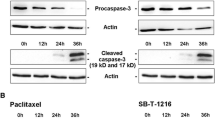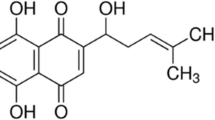Abstract
Background
There are two fundamental forms of cell death: apoptosis and necrosis. Molecular studies of cell death thus far favor a model in which apoptosis and necrosis share very few molecular regulators. It appears that apoptotic processes triggered by a variety of stimuli converge on the activation of a member of the caspase family, such as caspase 3, which leads to the execution of apoptosis. It has been suggested that blocking of caspase activation in an apoptotic process may divert cell death to a necrotic demise, suggesting that apoptosis and necrosis may share some upstream events. Activation of caspase is preceded by the release of mitochondrial cytochrome C.
Materials and Methods
We first studied cell death induced by β-lapachone by MTT and colony-formation assay. To determine whether the cell death induced by β-lapachone occurs through necrosis or apoptosis, we used the PI staining procedure to determine the sub-G1 fraction and the Annexin-V staining for externalization of phophatidylserine. We next compared the release of mitochondrial cytochrome C in apoptosis and necrosis. Mitochondrial cytochrome C was determined by Western blot analysis. To investigate changes in mitochondria that resulted in cytochrome C release, the mitochondrial membrane potential (delta psi) was analyzed by the accumulation of rhodamine 123, a membrane-permeant cationic fluorescent dye. The activation of caspase in apoptosis and necrosis were measured by using a profluorescent substrate for caspase-like proteases, PhiPhiLuxG6D2.
Results
β-lapachone induced cell death in a spectrum of human carcinoma cells, including nonproliferating cells. It induced apoptosis in human ovary, colon, and lung cancer cells, and necrotic cell death in four human breast cancer cell lines. Mitochondrial cytochrome C release was found in both apoptosis and necrosis. This cytochrome C release occurred shortly after β-lapachone treatment when cells were fully viable by trypan blue exclusion and MTT assay, suggesting that cytochrome C release is an early event in β-lapachone induced apoptosis as well as necrosis. The mitochondrial cytochrome C release induced by β-lapachone is associated with a decrease in mitochondrial transmembrane potential (delta psi). There was activation of caspase 3 in apoptotic cell death, but not in necrotic cell death. This lack of activation of CPP 32 in human breast cancer cells is consistent with the necrotic cell death induced by β-lapachone as determined by absence of sub-G1 fraction, externalization of phosphatidylserine.
Conclusions
β-lapachone induces either apoptotic or necrotic cell death in a variety of human carcinoma cells including ovary, colon, lung, prostate, and breast, suggesting a wide spectrum of anti-cancer activity in vitro. Both apoptotic and necrotic cell death induced by β-lapachone are preceded by a rapid release of cytochrome C, followed by the activation of caspase 3 in apoptotic cell death but not in necrotic cell death. Our results suggest that β-lapachone is a potential anti-cancer drug acting on the mitochondrial cytochrome C-caspase pathway, and that cytochrome C is involved in the early phase of necrosis.





Similar content being viewed by others
References
Raffray M, Cohen GM. (1997) Apoptosis and necrosis in cytoxicology: a continuum or distinct modes of cell death? Pharmacol. Ther. 75: 153–177.
Nicholson DW, Ali A, Thornberry NA et al. (1995) Identification and inhibition of the ICE/CED-3 protease necessary for mammalian apoptosis. Nature 376: 37–43.
Liu X, Kim CN, Yang J, Jemmerson R, Wang X. (1996) Induction of apoptotic program in cell-free extracts: requirement for dATP and cytochrome C. Cell 86: 147–157.
Green DR, Reed JC. (1998) Mitochondria and apoptosis. Science 281: 1309–1312.
Hooker SC. (1936) Lomatiol. Part II. Its occurrence, constitution, relation to and conversion into lapachol. Also, a synthesis of lapachol. J. Am. Chem. Soc. 58: 1181–1190.
Goncalves de Lima O, D’Albuquerque IL, Goncalves de Lima C, Dalia Maia MH. (1962) Substancias antimicrobianas de plantas superiores. Rev. Inst. Antibiot. Univ. Recife 4: 3–17.
Planchon SM, Wuerzberger S, Frydman B, et al. (1995) β-lapachone-mediated apoptosis in human promyelocytic leukemia (HL-60) and human prostate cancer cells: a p53 independent response. Cancer Res. 55: 3706–3711.
Li CJ, Wang C, Pardee AB. (1995) Induction of apoptosis by beta-lapachone in human prostate cancer cells. Cancer Res. 55: 3712–3715.
Li CJ, Friedman DJ, Wang C, Metelev V, Pardee AB. (1995) Induction of apoptosis in uninfected lymphocytes by HIV-1 tat protein. Science 268: 429–431.
Zhang G, Gurtu V, Kain SR, Yan G. (1997) Early detection of apoptosis using a fluorescent conjugate of annexin V. BioTechniques 23: 525–531.
Zou H, Henzel WJ, Liu X, Lutschg A, Wang X. (1997) Apaf-1, a human protein homologous to C. elegans CED-4, participates in cytochrome C-dependent activation of caspase-3. Cell 90: 405–413.
Packard BZ, Toptygian DD, Komoriya A, Brand L. (1996) Profluorescent protease substrates: intramolecular dimers described by the exciton model. Proc. Natl. Acad. Sci. U.S.A. 93: 11640–11645.
Vander Heiden MG, Chandel NS, Williamson EK, Schumacker PT, Thompson CB. (1997) Bcl-xL regulates the membrane potential and volume homeostasis of mitochondria. Cell 91: 627–637.
Metivier D, Dallaporta B, Zamzami N, et al. (1998) Cytofluorometric detection of mitochondrial alterations in early CD95/Fas/APO-1-triggered apoptosis of Jurkat T lymphoma cells. Comparison of seven mitochondrion-specific fluorochromes. Immunol. Lett. 61: 157–163.
Janicke RU, Ng P, Sprengart ML, Porter AG. (1998) Caspase-3 is required for alpha-fodrin cleavage but dispensable for cleavage of other death substrates in apoptosis. J. Biol. Chem. 273: 15540–15545.
Wuerzberger SM, Pink JJ, Planchon SM, Byers KL, Bornmann WG, Boothman DA. (1998) Induction of apoptosis in MCF-7:WS8 breast cancer cells by beta-lapachone. Cancer Res. 58: 1876–1885.
Acknowledgment
This work was supported in part by RO1CA61253 from the National Institute of Health.
Author information
Authors and Affiliations
Corresponding author
Additional information
Communicated by A. Pardee.
Rights and permissions
About this article
Cite this article
Li, YZ., Li, C.J., Pinto, A.V. et al. Release of Mitochondrial Cytochrome C in Both Apoptosis and Necrosis Induced by β-Lapachone in Human Carcinoma Cells. Mol Med 5, 232–239 (1999). https://doi.org/10.1007/BF03402120
Accepted:
Published:
Issue Date:
DOI: https://doi.org/10.1007/BF03402120




